
In my Royal Tour of India and Bhutan post, I talked about having a walk down the memory lane during this stay at home period due to the COVID-19. Going back through those memories is actually very exciting and nostalgic. The second walk down was to the day where the Royal Journey of Catherine Middleton officially began. The Duke and Duchess of Cambridge will be celebrating their Wedding Anniversary with their three kids. Today, I am going to talk about the day when it all officially began – April 29th, 2011 – The day Prince William and Catherine Middleton got married and became The Duke and Duchess of Cambridge.

I have been following the love story of the Royal Prince, who will be a King one day and a Middle-Class British Girl since the early 2000s. I remember sitting in front of my old computer and going through Catherine’s pictures (the better word would be papped pictures and the harassment Catherine went through). At that time my young naïve mind never realized how difficult it must be for a young girl who is trying to grasp the edges of her very private life that became an open public book. (One day I will write about Catherine’s pre-wedding life too).

And finally, the day arrived. On November 16, 2010, Prince William and Catherine Middleton announced their engagement. William presented his long-time girlfriend officially for the first time in front of the public and media as his Wife-to-be. I still remember the couple’s engagement announcement on November 16, 2010, like it was yesterday. The couple appeared for a photocall in the State Apartments of St James’s Palace, London, to mark their engagement before sitting down for a lovely interview.
The interview was the first time when we heard Catherine speaking and we got our first official glimpse of real Catherine who will be our Queen Consort one day. It was the beginning of the new Royal era. British Royal Family does not need any sort of introduction in any part of this world. But the late ’90s and early 2000s were not very good years for the Monarchy due to the string of never-ending family scandals.
The Middle-class fiancée of Royal Prince was the breath of fresh air in thousand years old Traditional House of Windsor. A new community of Royal Watching was born that day and the days leading to the wedding days were full of joy and excitement. Many around the globe were happy and excited to see the real-life Cinderella marrying her Prince Charming. After a long time, we were going to have a Royal Fashion icon.

And we were not disappointed. Catherine made her first official public appearance in a stunning high-street Issa Silk-jersey wrap-effect dress paired with Tiffany & Co Sapphire Oval Cabochon Earrings and Necklace and Episode ‘Angel’ Black Suede Platform Court Shoes. Her outfit was emphasising her iconic Sapphire and Diamond Engagement Ring. The days leading to the Royal wedding in 2011 were majestically full of excitement.
The 5 months long engagement period was full of speculations i.e. Wedding dress, wedding venue, bridal party, wedding broadcast etc. etc. We were getting new rumours every day while William and Catherine were preparing for their big day that was considered a ‘semi-state’ wedding as William is not the direct heir to the throne. Catherine undertook few royal engagements with Prince William around the United Kingdom. In December we found that Westminster Abbey will be the Wedding venue.
Two days before her wedding day, Catherine arrived at the Goring Hotel with her family. She spent her last night as the unmarried girl with her parents and siblings at the five-star hotel half a mile away from Buckingham Palace. The soon-to-be Duchess enjoyed a pre-wedding bash with family and friends ahead of her big day at the Hotel. The media and public were gathered outside the hotel, Palace, Westminster Abbey and along the Mall. I have always loved this moment of Catherine waving at the fans like a regal Queen.
Planning a Royal event is not a game and when it is a wedding, everything was going to rehearsed to the last dot of perfection. That happened in April 2011 too. For the final rehearsal, hundreds of soldiers started before dawn at 04:30 AM and continued into daybreak. The whole wedding day was rehearsed before the actual wedding. Even the car that carried Catherine and her father from Goring to the Westminster Abbey was seen among the final rehearsals. The couple came for the final rehearsal with the clergy before the broadcast team’s rehearsal.
First to arrive at the abbey were two of the royal fleet of Rolls-Royces which pulled up at about 4.50 am. Shortly after 5 am, the action began. The sounds of orders being barked out emerged from the final stretch of the route running down from the Houses of Parliament to the abbey.
Several companies of the Royal Navy lined the end of the route, preceded by the Army lining Parliament Street. Soldiers filed along the route up to the Cenotaph outside the entrance to Downing Street. From there, the RAF lined the road up to Horse Guards Parade which the royal convoy will pass through on Friday.
An RAF officer walking the line said to the troops: ‘On the day, you’ll have your heels on the white line (of the road markings),’ making sure they knew to take an extra step back closer to the crowds. When the couple leaves the abbey as man and wife, two groups of 12 military personnel will line their route as they make their way to their horse-drawn coach. The tribute is traditionally performed at many military weddings.
Dozens of soldiers on horseback from the Household Cavalry made their way to Westminster Abbey via a different route from the wedding cars this morning. The cavalry, who led the cars and carriages back to Buckingham Palace through the arch of Horse Guards Parade and along the Mall, performed a loop, parading down Buckingham Palace Road and along Victoria Street to get them to the Abbey.
As the excitement about the Royal Wedding increased, many die-hard Royal fans started camping outside Westminster Abbey 3 days before the actual wedding day to get a perfect view of the couple during the procession. On March 21, 2011, The Royal Mint unveiled the official UK coin commemorating the wedding of HRH Prince William of Wales and Miss Catherine Middleton. The wedding day, that also was St. Catherine’s day, was announced a Bank holiday in the United Kingdom. The holiday was also extended to British territories like Bermuda, Turks and Caicos, and the Falkland Islands.
Westminster Abbey was decorated with English Field Maples and four tons of foliage for the wedding. Eight 20 foot high English field maple and hornbeam trees in planters lined the nave and the couple chose flowers and trees sourced from Royal estates and other British growers, including azaleas, rhododendron, euphorbias, wisteria, beech and lilac. The English field maples were replanted at Prince Charles’ vacation home in Wales after the wedding.
Catherine chose the Middleton family’s florist, Emma Sampson and Shane Connolly as the Royal Wedding Florist. The decoration theme of the historic church was to create a ‘Living Avenue’ under which guests will walk to their seats. The tree planters were designed by Shane Connolly and hand-crafted by artisans on the Prince of Wales’s Highgrove estate.

St. James Palace, the then office of Prince William and Prince Harry, shared the order of Service ahead of the wedding. Read the full Order of Service here. The wedding was set to take place at 11 O’clock sharp on Friday, April 29th, 2011.
Guests began arriving at the Great North Door of Westminster Abbey from 8:15 a.m. while dignitaries started arriving shortly before 10 a.m. In the early morning of April 29, The Queen conferred titles upon Prince William and Miss Middleton. Henceforth they are known as The Duke of Cambridge, Earl of Strathearn and Baron Carrickfergus, and The Duchess of Cambridge, Countess of Strathearn and Baroness of Carrickfergus.
Prince William along with his best man and younger brother Prince Harry left the official residence of his father Prince Charles, at 10:10 AM in a Bentley State Limousine and arrived at the Abbey at 10:18 AM followed by representatives of foreign royal families, the Middleton family and then British Royal Family. Queen Elizabeth and Prince Philip were the last to leave Buckingham Palace at 10:40 AM.
Both Prince William and Prince Harry chose custom made versions of their military attires with William choosing Irish Guards’ uniform. The uniform was designed by Kashket and Partners. It was reported that their Uniforms were sweatproof. The label also designed the dress worn by Page Boys during the wedding.
An interesting tidbit – As the military uniform does not have pockets, Harry’s uniform had a special gold embroidered cuff which was attached to Harry’s jacket. Sewn inside was a secret compartment in which Harry carried the Welsh Gold Wedding Ring. The cuff was made from a heavyweight Melton wool fabric embroidered with a two per cent pure gold wire. More from Daily Mail,
A spokesman said: ‘The team were asked to design a small pocket to keep Kate’s ring safe, particularly during the journey from Clarence House to Westminster Abbey, as Harry has no pocket in his military trousers. Harry, aware that he would be waving to the crowds, feared he may drop the ring and wanted a secret compartment.
The brothers wanted the day to run smoothly and decided this would be the best option. We were happy to oblige. A royal source added: ‘Prince Harry was terrified that he would arrive at the Abbey and find out that he had dropped the ring on the way. His brother was always ribbing him about it.
1,900 people attended the ceremony in the Abbey. It was reported that the list was actually longer but the couple decided to make it short. Some 600 people were invited to the luncheon reception at Buckingham Palace, hosted by the Queen. For the evening reception, Prince Charles of Wales hosted approximately 300 guests.
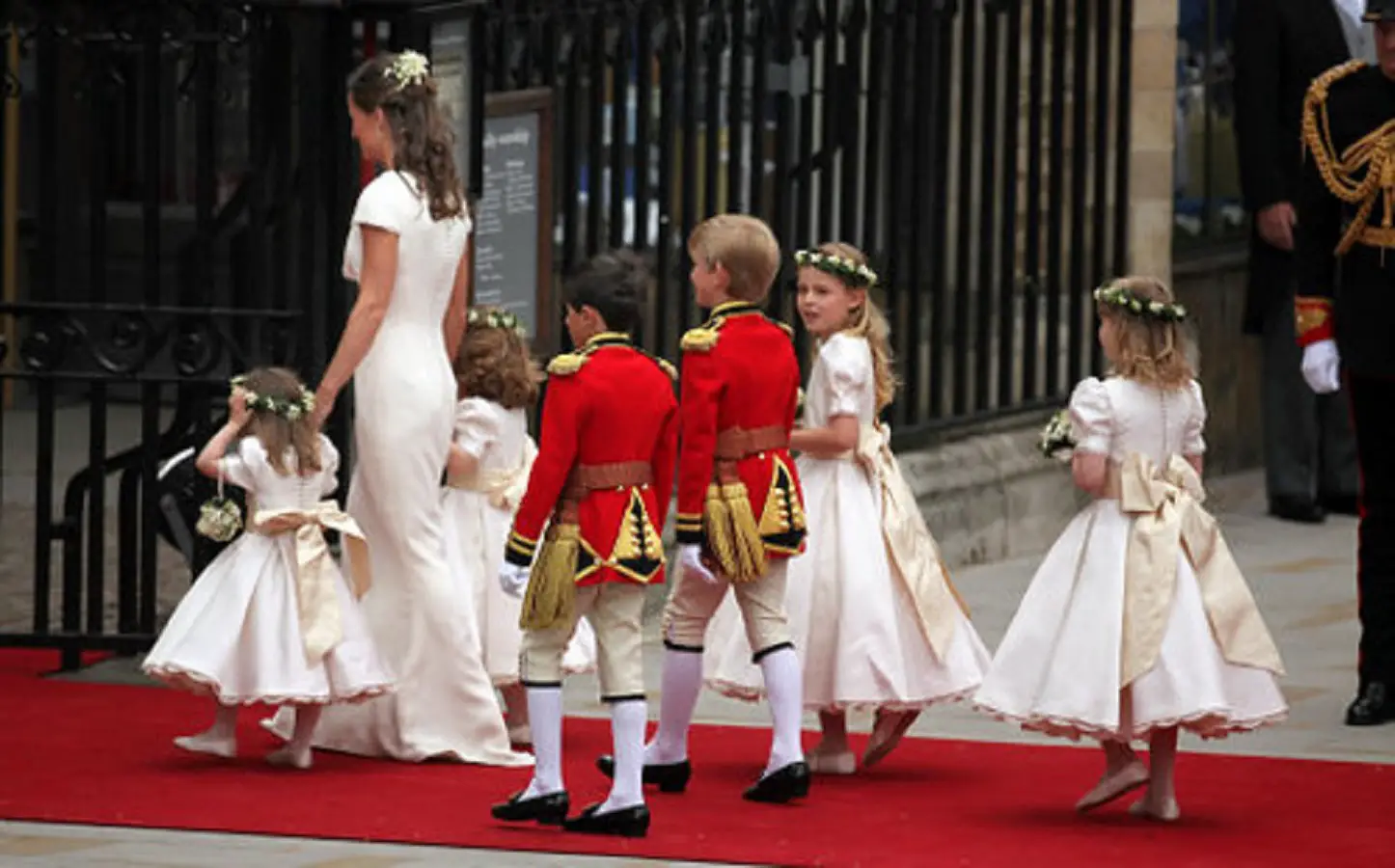
The bridal party, who had spent the night at the Goring Hotel, left for the ceremony in the former number one state Rolls-Royce Phantom VI at 10.52 am. Catherine chose her younger sister Pippa Middleton as her Maid of Honour. There were 4 bridesmaids in the bridal party and 2 Page boys:
- The Lady Louise Windsor (Aged 7 – daughter of The Earl and Countess of Wessex)
- The Hon. Margarita Armstrong-Jones (Aged 8 – daughter of Viscount and Viscountess Linley)
- Miss Grace van Cutsem (Aged 3 – daughter of Mr and Mrs Hugh van Cutsem)
- Miss Eliza Lopes (Aged 3 – daughter of Mr and Mrs Harry Lopes)
- Master William (Billy) Lowther-Pinkerton (Aged 10 – son of Mr and Mrs Jamie Lowther-Pinkerton)
- Master Tom Pettifer (Aged 8 – son of Mr and Mrs Charles Pettifer )
Miss Grace van Cutsem and Master Tom Pettifer are godchildren of Prince William. Catherine paid a sweet tribute to her mother at the royal wedding. The junior bridesmaids and flower girls wore flower crowns modelled after the one Carole Middleton wore in her own wedding in 1981.
And then the moment we were waiting for 5 months came. The beautiful bride and her father left the Goring at the precise time of 10:48 a.m.
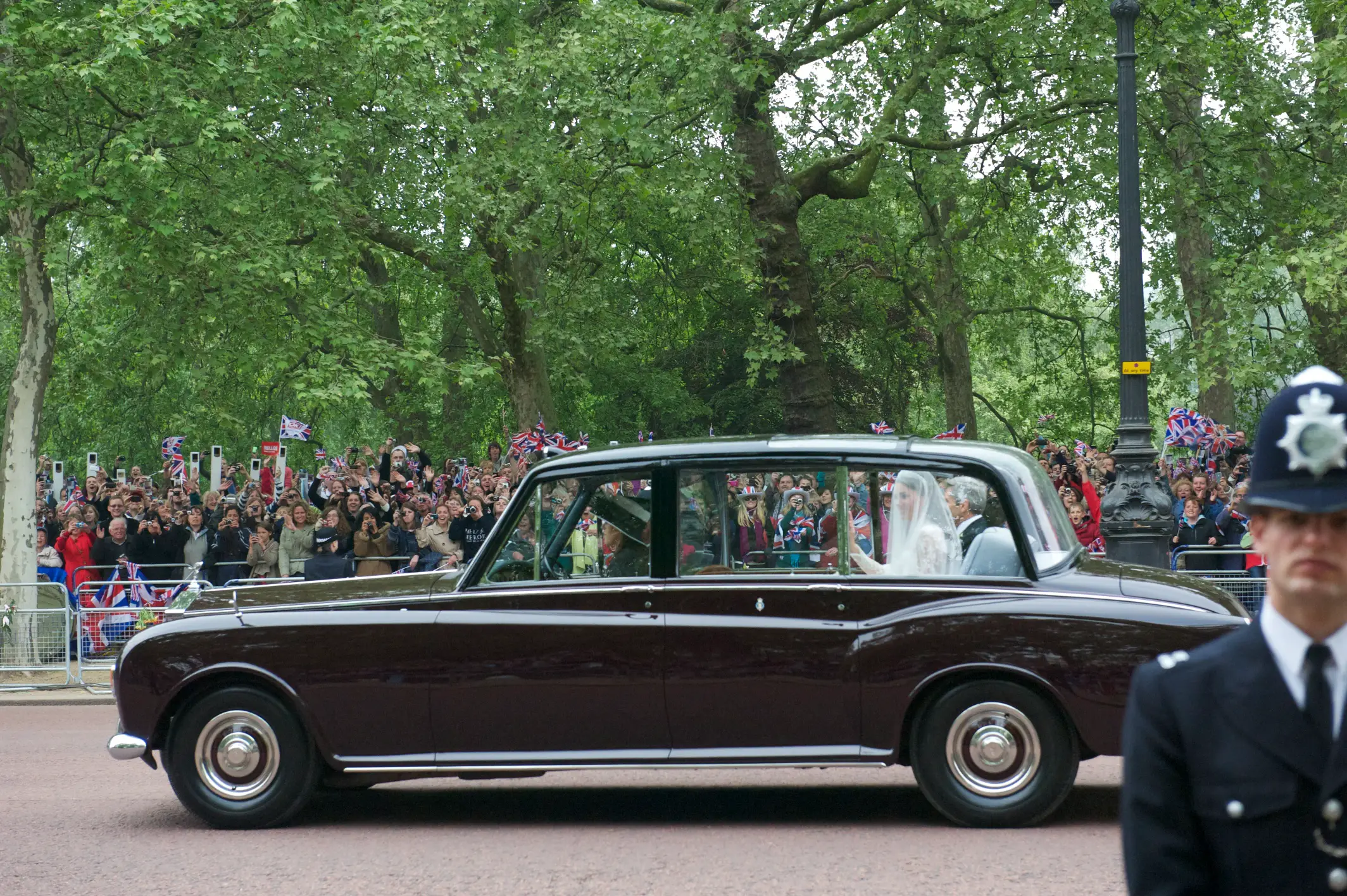
Catherine Middleton travelled in a Rolls-Royce Phantom VI Silver Jubilee Car with her father from the Goring Hotel, down The Mall to Parliament Square.
The Rolls-Royce Phantom VI was presented to the Queen for her Silver Jubilee. The seven-seater car features toughened glass and a custom-made silver model of St George slaying a dragon.
The Bride and her father arrived at the Westminster Abbey amid the beautiful music of Webbey’s ringing bells. When Catherine stepped out of the car outside the Abbey, we got the first complete look of her wedding gown. From Stella McCartney to Alicia Temperley almost every major British designer was on the rumoured list of Wedding gown designer.

Catherine Middleton knew that choosing the designer and gown design is no easy fate. The wedding gown has to live through history. Millions of people will be waiting for the moment she will step out wearing her wedding gown so it has to be historic, modern and Catherine at the same time. Just a couple of weeks before the wedding, Sarah Burton’s name came in the new for the first time. The Creative designer of British label Alexander McQueen was being reported as the chosen one for the big day. It was being said during the days before the wedding that Stella McCartney has recommended the Cheshire born designer to Catherine. Sarah Burton was seen delivering the wedding and reception dresses to Catherine during the final dress rehearsals at Clarence house.
Palace announced the name of the designer officially when Catherine arrived at the Westminster Abbey. The Palace said,
“Miss Middleton chose British brand Alexander McQueen for the beauty of its craftsmanship and its respect for traditional workmanship and the technical construction of clothing. Miss Middleton wished for her dress to combine tradition and modernity with the artistic vision that characterises Alexander McQueen’s work. Miss Middleton worked closely with Sarah Burton in formulating the design of her dress. The dress epitomises timeless British craftsmanship by drawing together talented and skilled workmanship from across the United Kingdom. The dress design pays tribute to the Arts and Crafts tradition, which advocated truth to materials and traditional craftsmanship using simple forms and often Romantic styles of decoration.”

Catherine chose an ivory satin and lace gown. The ivory satin bodice was padded slightly at the hips and narrowed at the waist, and was inspired by the Victorian tradition of corsetry that is a particular Alexander McQueen hallmark and 1950s fashion. The lace bodice features V-neck line and long sleeves.

The ivory gown made of white satin gazar featured overall lace applique work with floral detail, the full satin gazar skirt with box pleats and arches, the back leading to a 9ft train while the underskirt was made of silk tulle trimmed with Cluny lace. The silhouette of the skirt echoes an opening flower.
The gown has a lace bodice with V-neck line and long sleeves. The lace detail on the elegant gown incorporated the rose, thistle, daffodil and shamrock. The back of the dress was finished with fifty-eight gazar and organza-covered buttons fastened by Rouleau loops.

Catherine’s veil was made of layers of ivory silk-tulle with a trim of hand-embroidered flowers. Read more about Catherine’s wedding gown and veil here.
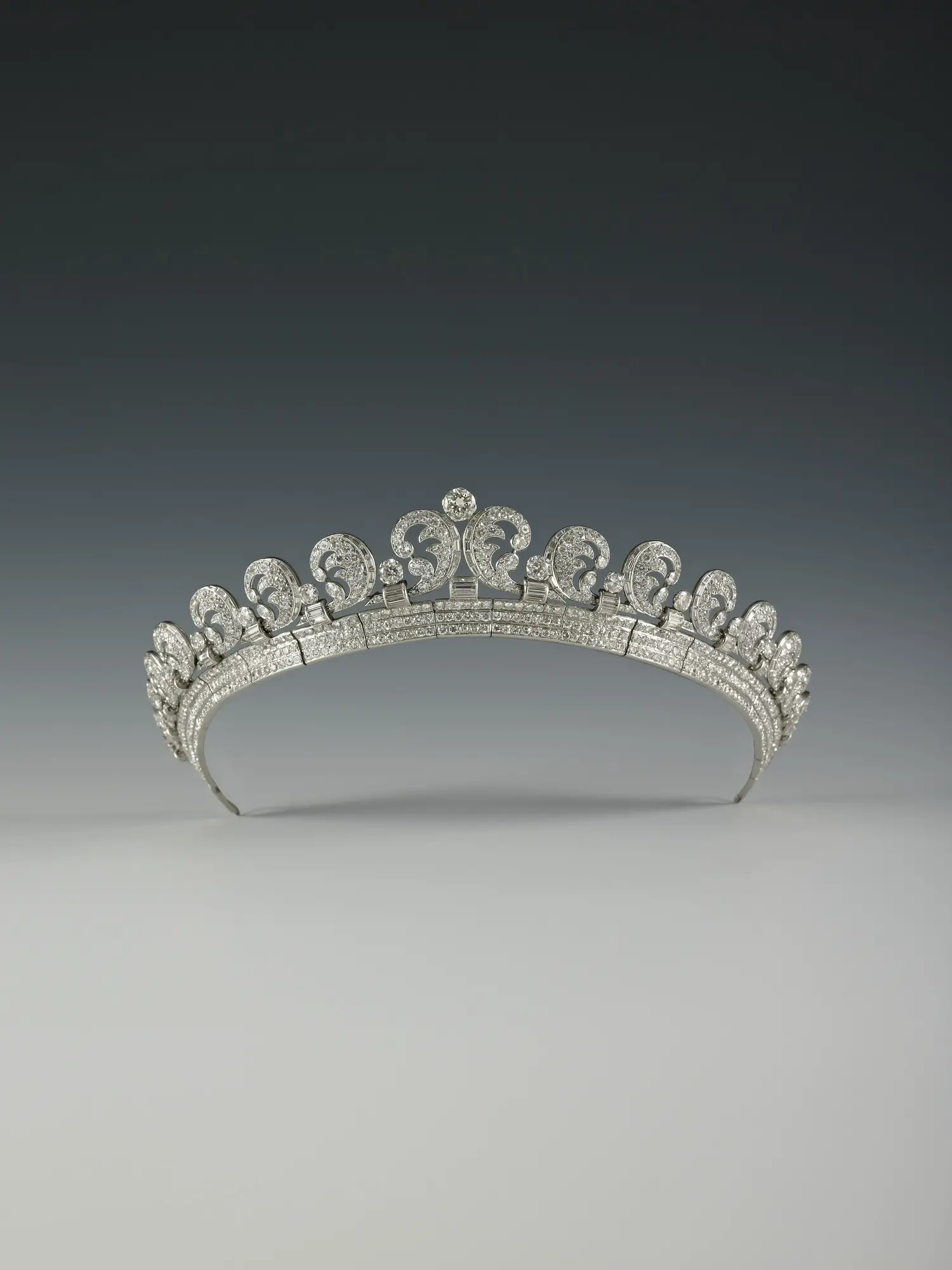
Catherine paired the ivory gown with Cartier Halo Tiara that was lent to her by The Queen. Designed by Cartier in 1936 the diamond ‘halo’ tiara formed as a band of 16 graduated scrolls, set with 739 brilliants and 149 baton diamonds, each scroll divided by a graduated brilliant and with a large brilliant at the centre. More about Tiara here.

The bride chose the theme of ‘Something old, Something new, Something Borrow, Something Blue’ at her wedding. There was some old lace sewn in her wedding gown with blue ribbons. Cartier Halo Tiara was the borrowed element.

Her parents fulfilled the new element of the theme. Michael and Carole Middleton gifted their daughter a stunning pair of diamond earrings – Robinson Pelham Wedding Earrings that Catherine wore on her wedding day. The earrings feature stylised oak leaves with a pear-shaped diamond set drop and pave set diamond acorn suspended in the centre.
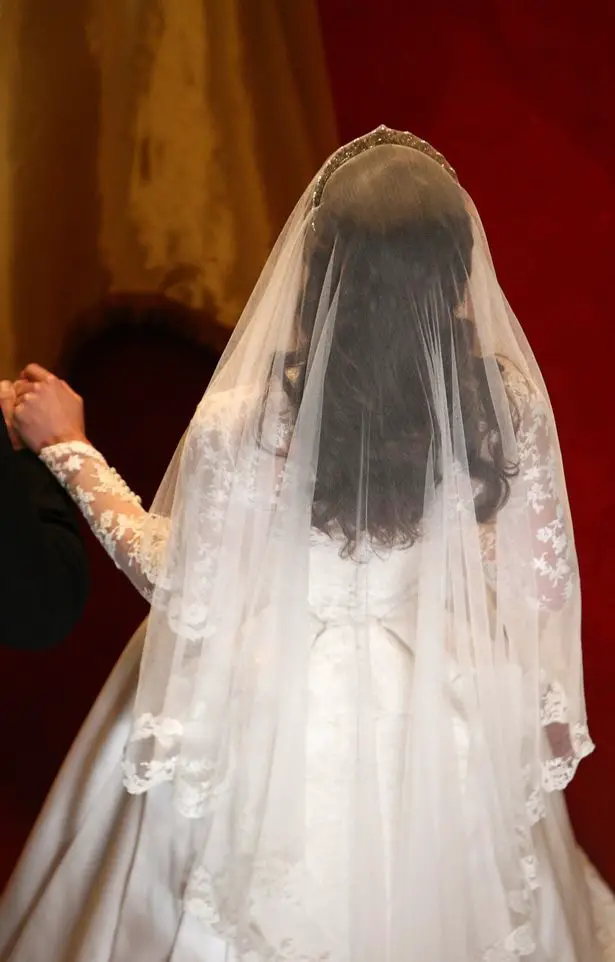
Catherine wore her hair in a simple but elegant demi chignon created by Chelsea based Richard Ward Salon’s, James Pryce.

Catherine wore the ivory white Duchesse satin Alexander McQueen shoes. The shoes were hand-embroidered with Sophie Hallette lace by the Royal School of Needlework with similar appliques that were designed on her wedding dress.
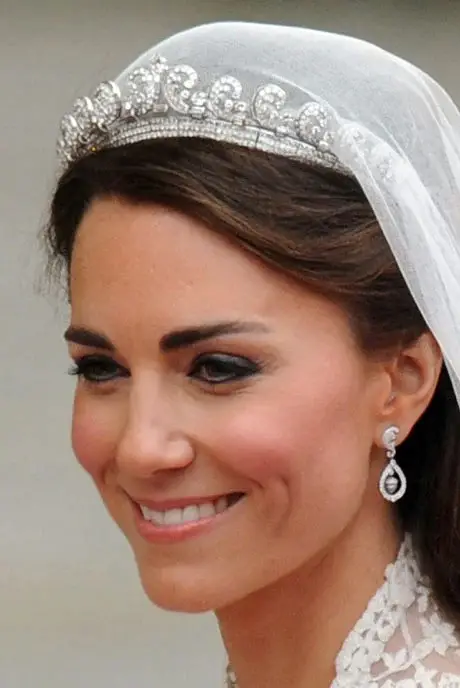
Surprising the wedding watchers, Catherine did her own makeup with the help of a make-up artist named Arabella Preston from Bobbi Brown. Her softly romantic wedding look featured soft smoky eye, pink blush with a matching pink lipstick.
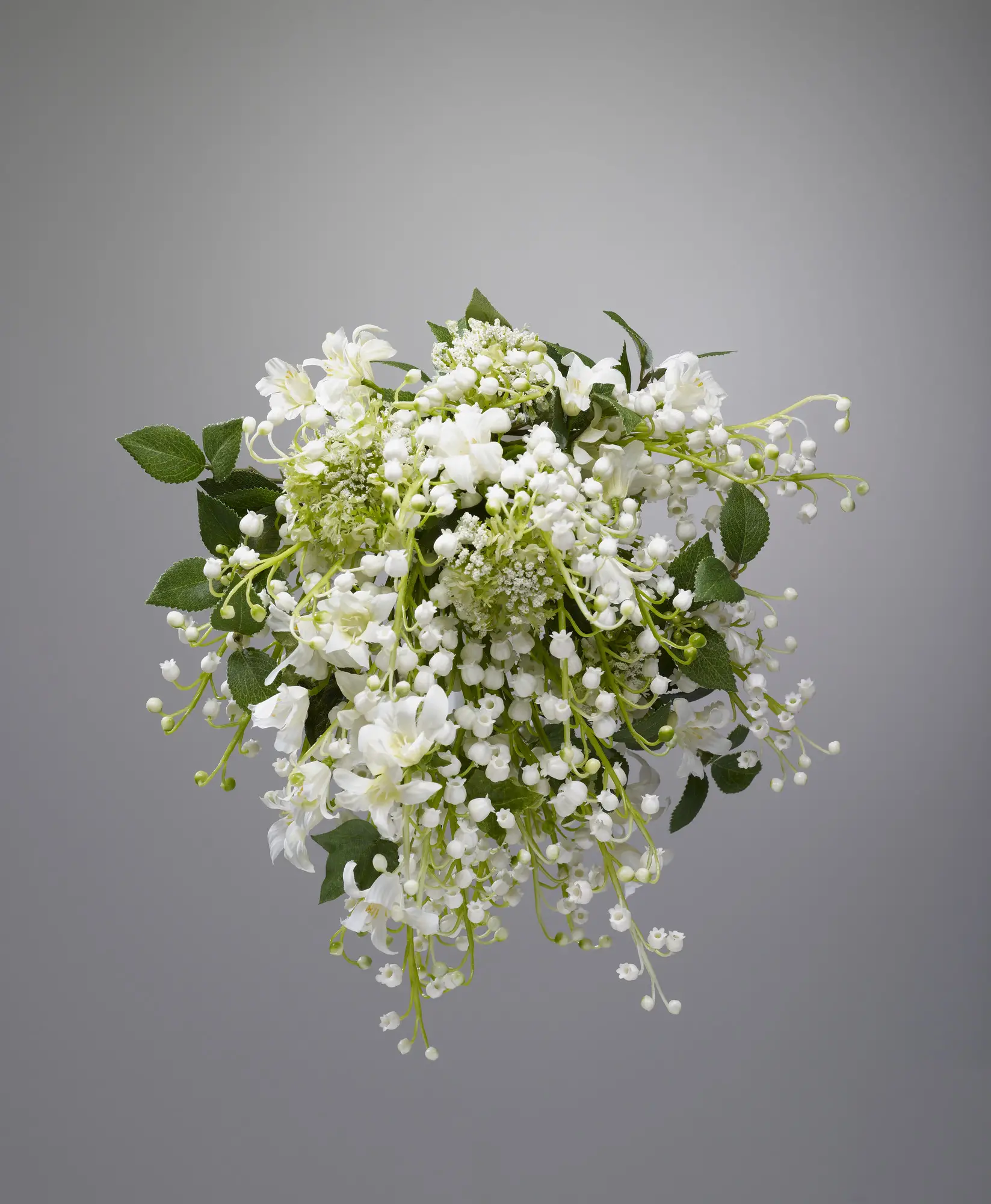
Miss Middleton carried a bouquet of myrtle, lily-of-the-valley, sweet William, ivy, myrtle and hyacinth designed by Shane Connolly from the flowers of significance for the Royal family and the Middleton family. After the wedding, as per the custom, the bouquet was laid on the grave of an unknown warrior at Westminster Abbey. About the bouquet Palace said,
The flowers’ meanings in the bouquet are:
- Lily-of-the-valley Return of happiness
- Sweet William Gallantry
- Hyacinth Constancy of love
- Ivy: Fidelity; marriage; wedded love; friendship; affection
- Myrtle: the emblem of marriage; love.
The bouquet contains stems from a myrtle planted at Osborne House, Isle of Wight, by Queen Victoria in 1845, and a sprig from a plant grown from the myrtle used in the Queen’s wedding bouquet of 1947.
The tradition of carrying myrtle begun after Queen Victoria was given a nosegay containing myrtle by Prince Albert’s grandmother during a visit to Gotha in Germany. In the same year, Queen Victoria and Prince Albert bought Osborne House as a family retreat, and a sprig from the posy was planted against the terrace walls, where it continues to thrive today.
The myrtle was first carried by Queen Victoria eldest daughter, Princess Victoria when she married in 1858 and was used to signify the traditional innocence of a bride.
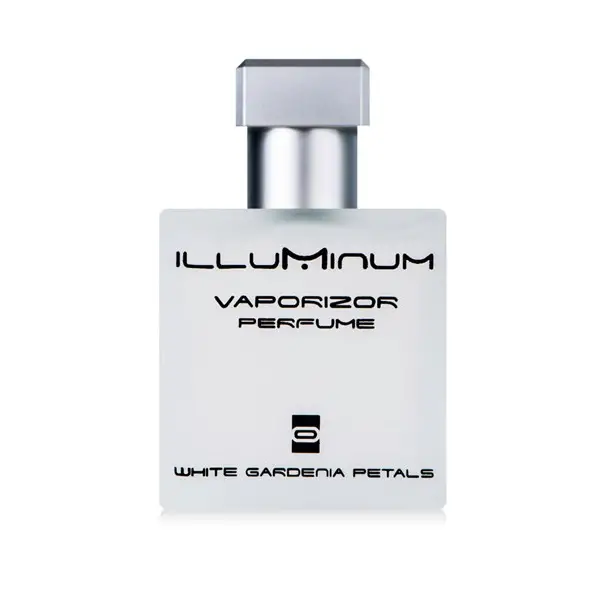
Clarence House received numerous queries about which perfume Catherine used on her wedding and finally disclosed that she used White Gardenia Petals by Illuminum. It was described as, “A delicate, refined scent, the top note of lily evokes summer ambience, whilst heart notes of gardenia, ylang-ylang and jasmine are sumptuous and feminine. Amber wood underscores this light bouquet”.
Catherine accompanied by her father entered through the Great West Door and was met by the Dean and joined by the Bridesmaids and Pages.
Once Catherine was inside the Abbey (and Sarah Burton was done with setting up her train for the procession), Diccon Ramsay, the then stage manager of the U.K.’s X-Factor, sent Catherine a signal to walk down the aisle. He also led all of the television shots for the production of the wedding that viewers around the world watched live.
Catherine and her bridal party made her three-and-a-half-minute procession through the nave while the choir sang “I was glad”, an anthem by Sir Hubert Parry composed in 1902 for the coronation of King Edward VII.

When Catherine reached the aisle, it was reported that William told her, “you are looking beautiful”.

A beautiful moment where Michael Middleton raised Catherine’s veil. The service proceeded with the formal service and congregational singing three well-known hymns, fanfares, anthems, organ and orchestral music. Prince Charles helped in picking out a few classical songs that were played in the church during the ceremony.
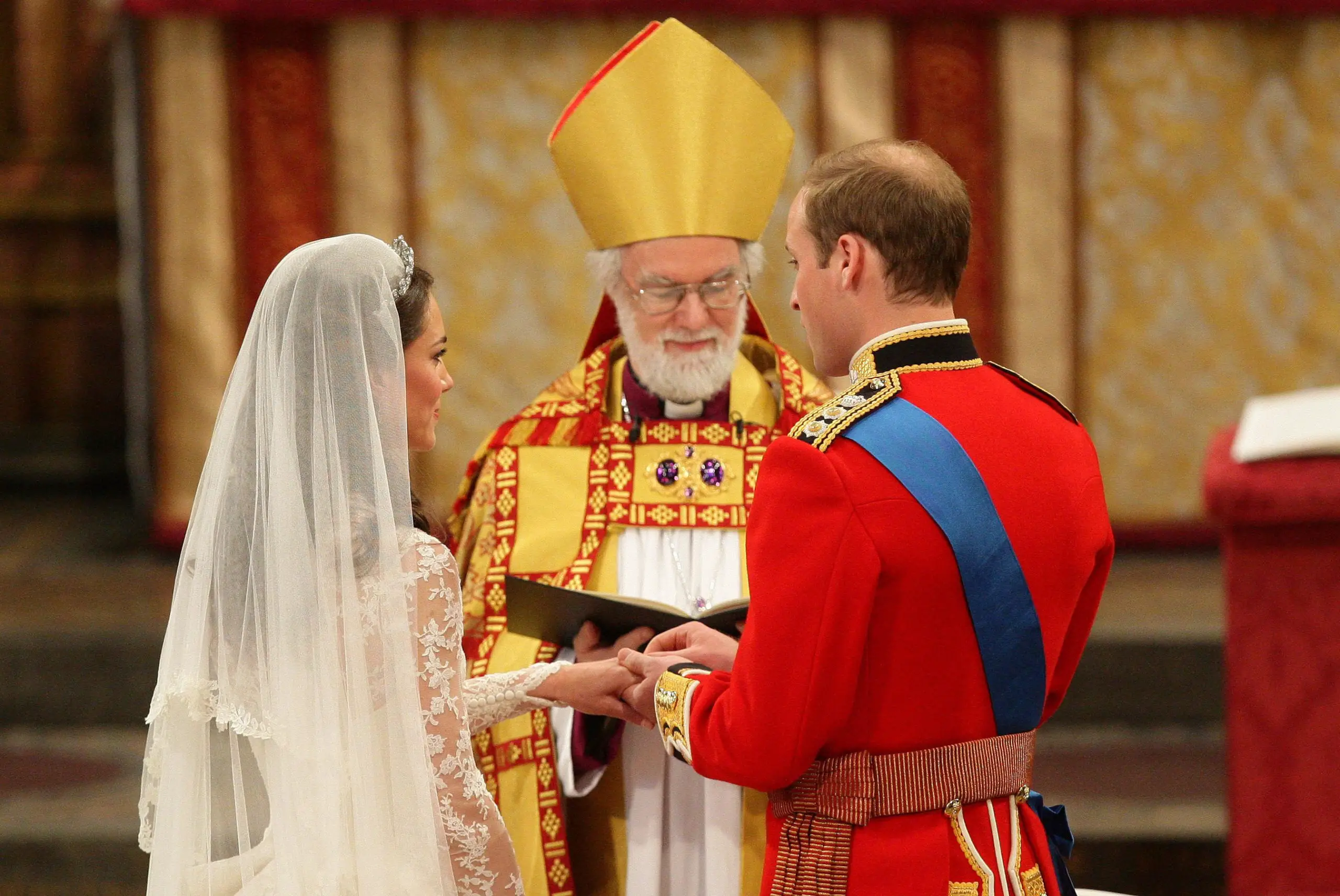
The service was scheduled to begin at 11 a.m. and was relayed to well-wishers along the ceremonial route by audio speakers. The first was hymn was the “Guide Me, O Thou Great Redeemer” sung to the tune “Cwm Rhondda”. The hymn, originally written in Welsh by 18th-century Methodist preacher William Williams, had been sung at the funeral of Diana, Princess of Wales.
The words to their second hymn, “Love Divine, All Loves Excelling”, was by Charles Wesley and its tune – Blaenwern – was composed by William Penfro Rowlands, during the 1904–1905 Welsh Revival. This hymn was sung at the Prince of Wales’s 2005 marriage to the Duchess of Cornwall. The third hymn was “Jerusalem”, based on the poem by William Blake and set to music by Sir Charles Hubert Hastings Parry.

The couple said their vows in front of the congregation. The beautiful couple promised to “love, comfort, honour and keep” each other.
The Dean of Westminster conducted the service, the Archbishop of Canterbury married the couple and the Bishop of London gave the address.
William said, “I, William Arthur Philip Louis, take thee, Catherine Elizabeth, to my wedded wife, to have and to hold from this day forward, for better, for worse: for richer, for poorer; in sickness and in health; to love and to cherish, till death us do part, according to God’s holy law; and thereto I give thee my troth.“.
Catherine said, “I, Catherine Elizabeth, take thee, William Arthur Philip Louis, to my wedded husband, to have and to hold from this day forward, for better, for worse: for richer, for poorer; in sickness and in health; to love and to cherish, till death us do part, according to God’s holy law; and thereto I give thee my troth.“

William put the Welsh Gold Wedding Ring on Catherine’s finger and decided not to wear any ring. The wedding band was made by royal jewellers from Welsh gold, an almost century-old tradition started in 1923.

The lesson from the Epistle to the Romans was read by Catherine’s brother James Middleton.
The couple was accompanied by Prince of Wales, The Duchess of Cornwall, Prince Harry and the Middleton family for the signing of the official registers. Wing Commander Duncan Stubbs’s own composition, Valiant and Brave, was performed as the royal couple signed the wedding registers.
William and Catherine along with Maid of Honour and Best Man leaving the alter.
After signing the register, the newly married couple pay their respect to the Queen at the National Anthem.
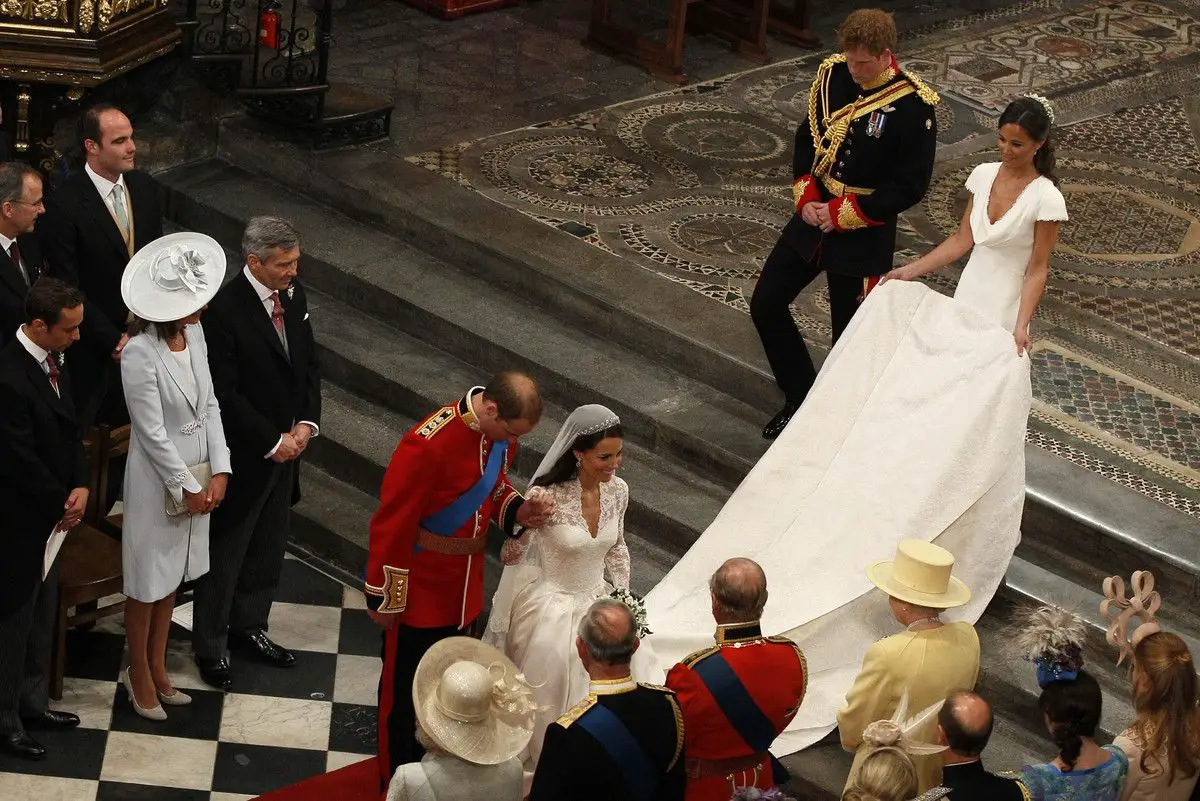
The Duke and Duchess of Cambridge bowed and curtsied to the Queen.
The couple started the procession towards the Great West Door as Charles Hubert Hastings Parry’s Blest Pair of Sirens (a setting of an ode by John Milton) was being sung.

And Ladies and Gentlemen, we have the Duke and Duchess of Cambridge.
Video of the wedding procession coming out of the Abbey.

After the ceremony that finished at 12.15 pm, the newly married couple, now titled Their Royal Highnesses The Duke and Duchess of Cambridge, travelled in a horse-drawn carriage procession to Buckingham Palace and were greeted along the streets by members of the public.

The just-married couple travelled in the 1902 State Landau along the Processional Route to Buckingham Palace. There were five horse-drawn carriages in the Procession, drawn from the Royal Mews. The Royal Mews houses 30 carriage horses and has 38 staff including liveried helpers, coachmen, chauffeurs. There are two breeds of horses at the Royal Mews, Windsor Greys and Bays (the majority of which are Cleveland Bays). There are over 100 carriages in the collection, although not all of them are kept at Buckingham Palace. The 1902 State Landau was specifically built for King Edward VII in 1902 and was intended to be used at his Coronation. It is the carriage in most general use at the Royal Mews and is usually used by The Queen to meet Foreign Heads of State when they arrive on State Visits to Britain.

They were followed by the bridal party in open carriages and members of the Royal Family.
The video of the Royal procession. Following the ceremony, the 10 bells of the Abbey were run in a full peal called “Spliced Surprise Royal” which means they rang with no break for over three hours. There was also a minimum of 5,040 different changes in sound that rang for more than three hours.

The Duke and Duchess of Cambridge arrived at the Buckingham Palace.

A beautiful moment when the newly married couple crossed the threshold together.
At 1.25 pm, The Duke and Duchess of Cambridge appeared on the balcony of Buckingham Palace for an RAF flypast and two kisses! They watched a flypast of an Avro Lancaster bomber, a Supermarine Spitfire fighter, and a Hawker Hurricane fighter aircraft from the Battle of Britain Memorial Flight, followed by two Typhoons from RAF Coningsby and two Tornado GR4s from RAF Leuchars in a flat diamond formation. When Duchess stepped out on the balcony she was amazed by the crowd. You can see her saying, “Oh, Wow!” in the above video.

A real pinch-me moment for the Duchess of Cambridge.

The Queen hosted a reception for the couple and their guests at Buckingham Palace and The Prince of Wales hosted a further private dinner in the evening. Catherine met world leaders, foreign royals and other dignitaries during the lunch reception at Buckingham Palace.
The couple’s wedding cake was made by Leicestershire-based cake designer Fiona Cairns. The cake was a multi-tiered traditional fruit cake decorated with cream and white icing in the Joseph Lambeth technique. The cake was commissioned on February 18, 2011.
The traditional fruit cake with ivory and white icing consists of 8 tiers and 17 cakes. It is decorated with the national emblems of rose, thistle, shamrock and daffodil and the crowned cypher of The Duke and Duchess. Cairns and her team showed up at Buckingham Palace to start building the eight-tier fruitcake in March.
The decoration also includes flower garlands, bows, oak leaves and acorns inspired by the architectural details of the Picture Gallery at Buckingham Palace. In total, the decoration incorporates 900 delicate sugar-paste flowers to decorate the couple’s wedding cake. The Joseph Lambeth technique is derived from a style of decorating that was popular in England where chefs and decorators would use a lot of intricate piping to create 3-D scrollwork, leaves, flowers, and other decoration on a cake. The Lambeth Method is still popular today and is frequently used by wedding cake designers and decorators to create ornate wedding cakes. A cake decorated in the Lambeth Method and accented with fresh fruit or flowers is the wedding cake of choice for anyone who wants a traditional-looking, elegant wedding cake.
A team of 8 worked on the cake for a period of two months and the royal pastry chefs Kathryn Boyden and Jane Fisher made the sugar lily-of-the-valley on top of the cake. The two top tiers were reserved for future use, as is the tradition, and the third tier was sliced and served to guests.
A further 17 sugar flowers, that had special meaning to the couple, were added, including sweet William and myrtle, which symbolises love and marriage. Cairns was also given a piece of lace from The Duchess’ wedding dress (unbeknownst to Cairns at the time) which was copied onto the cake itself. About the designer, Palace said, “Fiona was chosen for her creative style and beautifully crafted handmade cakes using traditional British ingredients. Her business started 25 years ago on her kitchen table, is now based in a state-of-the-art bakery in Leicestershire, the heart of the English countryside.”
Talking about her experience of designing a Royal wedding cake Cairns said, “In many ways, I would say that Kate designed her wedding cake because she knew very clearly what she wanted and did not want,” Cairns says. “The ideas came from her, we had meetings with her, and the brief was from Kate.”
“She put us absolutely at ease, she’s as natural and as lovely as we all see her in the media,” Cairns says about the Duchess of Cambridge. “It was a wonderful process.”
“We realized that it was a huge privilege that we were even being considered to make the wedding cake for the future king and queen of England. And it was an enormous responsibility from the very, very beginning,” Cairns says. “As soon as we were commissioned, from the time of the phone call, I had sleepless nights,” Cairns says. “We had to keep pinching ourselves. It’s a very important part of the royal wedding, and it was the biggest, most important commission that we as a business had ever received.”
The menu of the wedding breakfast was revealed several years later when a copy of the menu was sold at an auction. The wedding of the decade had South Uist salmon, Lyme Bay crab and Hebridean langoustines served as appetizers, followed by North Highland organic lamb with spring vegetables, English asparagus and Jersey Royal potatoes. The lamb came from Prince Charles’ organic farm. There were three desserts on the menu – Berkshire honey ice cream, sherry trifle and chocolate parfait with a glass of Rose champagne.
At Prince William’s request, one more cake was made as a groom’s cake. William requested McVitie’s Cake Company to create a chocolate biscuit cake for the reception at Buckingham Palace.
This icebox cake is a favourite tea cake of the Prince, his late mother Princess Diana and Queen Elizabeth II.
The chocolate biscuit cake is made from a Royal Family recipe and was specially requested by Prince William.
McVitie’s Cake Company now part of the United Biscuits Group has made many of the wedding and christening cakes for members of the Royal family since the marriage of His Majesty King George V to HM Queen Mary. They also made the official cake for The Queen and Duke of Edinburgh’s diamond wedding anniversary in 2007.
The groom’s cake had 17 kilos of chocolate and some 1,700 of the company’s “Rich Tea” brand cookies.
At 3.35 pm surprising the fans who were still outside the Palace, Prince William drove his new wife back up the Mall for the short distance to Clarence House, his then-official London residence.

The blue two-seater Aston Martin DB6 Volante (MkII convertible) had been given to Prince Charles by the Queen as a 21st birthday present. It was decorated in the customary newlywed style by the best man and friends with balloons, ribbons, and a rear number plate that read “JU5T WED”.
In the evening, Prince Charles of Wales hosted a private reception for the 300 family and friends. The British pop star Elie Goulding sang several of her hits, as well as a beautiful cover of Elton John’s “Your Song” at the evening reception.
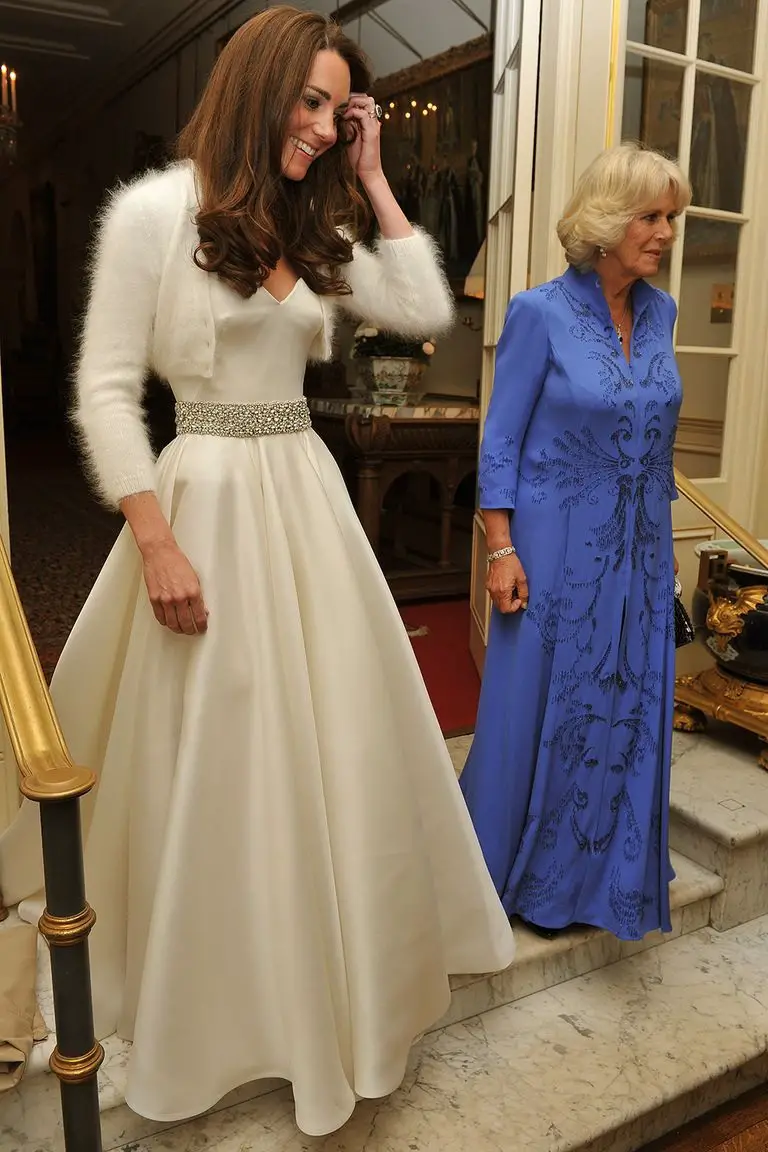
For the evening reception, the Duchess of Cambridge chose a white Alexander McQueen satin gown with a white shrug.
“Personally chosen by Prince William and Miss Middleton. Many of the charities are little known, without existing Royal Patronage, and undertake excellent work within specific communities. They are charities that have a particular resonance with Prince William and Miss Middleton and reflect issues in which the couple have been particularly interested in their lives to date.
The charities are grouped into particular areas, depending on the work they do, and individuals can donate to the group they particularly wish to support. The areas are: Changing Lives through Arts and Sport; Children Fulfilling Their Potential; Help and Care at Home; Support for Service Personnel and Their Families; and Conservation for Future Generations. The charities include some based in Canada, Australia and New Zealand, to reflect the couple’s close ties to and affection for the three countries following visits by Prince William in the past.
The donations will be held in a dedicated account by the Foundation of Prince William and Prince Harry and grants will be distributed in partnership with the benefitting charities to ensure maximum impact.”
In July 2011 it was reported that Royal Wedding Charitable Gift Fund received donations of a grand total of £1.5 million. Palace said,
Their Royal Highnesses the Duke and Duchess of Cambridge are delighted that these charities are able to benefit so positively from their special day. They would like to thank everyone who donated and contributed so generously to the charitable fund and for all the kindness and support shown to them throughout the wedding period.

The official photographs of the wedding were released next few days. The pictures were taken by Hugo Burnand in the Throne room of Buckingham Palace. Announcing the official photographer, Palace said,
HRH Prince William of Wales and Miss Catherine Middleton have selected Hugo Burnand to be their official photographer at their wedding on the 29th April. Mr Burnand will take the official photographs at Buckingham Palace following the wedding at Westminster Abbey. Mr Burnand has photographed Prince William privately before and was the official photographer at the wedding of The Prince of Wales and The Duchess of Cornwall 2005. He also took the official 60th birthday photograph of The Prince of Wales.

About his experience Bernard said, ”
“We had three weeks of serious pre-production organization and then three days right before the wedding when we set ourselves up at Buckingham Palace inside the Throne Room—it became our home,” he says.
The Throne Room was where Burnand and his team were to take those important historical portraits. “We wanted it to look like a spring day and, of course, no one knew if it would actually be a spring day so we lit it through the windows so it would, regardless,” he says.
In three minutes she sat down on the steps, Sarah Burton put the dress out perfectly, Prince William leant in, the children basically did what they felt was the right thing to do. That was a very spontaneous picture. That little detail there [points to Kate’s hand touching William’s knee] and William leaning in there, all these things were not directed, but a result of a good relationship with everyone.” It was Burnand’s favorite portrait from the day.
What a beautiful day it was. I do hope you would have enjoyed this walk down the memory lane after reading the post. As the couple is marking the day privately at home, I wish them a very Happy Wedding Anniversary. We will hear from the couple on Charlotte’s birthday in three days.
